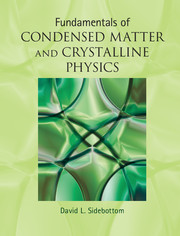 Fundamentals of Condensed Matter and Crystalline Physics
Fundamentals of Condensed Matter and Crystalline Physics 4 - Magnetic structure
from Part I - Structure
Published online by Cambridge University Press: 05 August 2012
Summary
Introduction
In this final chapter on the subject of structures, we turn our attention to magnetic materials. Why? Because magnetic materials are illustrative of yet another level of structure that often arises in condensed matter, beyond that of particle arrangements. As we will see, magnetic particles have a property of net spin and a magnetic moment whose orientation in space is largely unrestricted. Regardless of whether a large system of magnetic particles is positioned in an ordered or disordered manner, their spins represent an additional layer of ordering. The moments could be randomly oriented or aligned in a common direction. In ferromagnetic systems, these moments interact with one another to promote a local alignment of the moments which can eventually spread over the entire system. This is reminiscent of how pairwise bonding between particles eventually leads to crystallization of a liquid, and it is the archetype for a wide variety of phase transitions in which order appears in the form of correlated regions emerging from a disordered host.
The ordering process
So far, our discussion of structure has focused entirely on particles: their relative positions and the forces that hold them together. We have seen that arrangements of particles fall into either an ordered or disordered pattern which can be characterized by the level of symmetry present. By virtue of its disorder, the liquid has rotational invariance and an infinite symmetry (on average). The crystal, however, conforms to a space lattice and possesses only a discrete set of symmetry operations. In the process of forming a crystal from the liquid, the symmetry is often said to be “broken”.
- Type
- Chapter
- Information
- Fundamentals of Condensed Matter and Crystalline PhysicsAn Introduction for Students of Physics and Materials Science, pp. 50 - 66Publisher: Cambridge University PressPrint publication year: 2012
